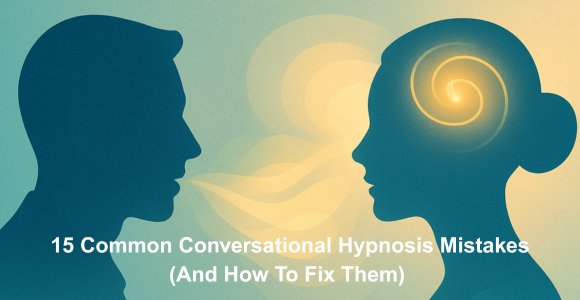![[ARTICLE] Conversational Hypnosis: 10 Careers Where This Unique Skill Gives You a Competitive Edge [ARTICLE] Conversational Hypnosis: 10 Careers Where This Unique Skill Gives You a Competitive Edge](https://hypnosistrainingacademy.com/wp-content/uploads/2025/08/conversational-hypnosis-career-advantage.jpg)
Picture this: You walk into a room, and within minutes, people feel naturally drawn to you. They listen more intently, open up more readily, and trust your guidance. They leave feeling understood, motivated, and genuinely helped.
Sound like a superpower? It’s not magic—it’s conversational hypnosis.
While most people think hypnosis only belongs in therapy offices or stage shows, in reality, conversational hypnosis can give you an advantage in any career that involves human interaction. The ability to build instant rapport, guide attention, and communicate with unconscious influence isn’t just for hypnotherapists—it’s a game-changing skill for professionals across countless fields.
Whether you’re looking to advance in your current role, positively influence more people, or considering a career change, let’s explore ten careers where conversational hypnosis can give you a powerful edge and might even make you the most impactful person in the room
Why Conversational Hypnosis Works: Understanding Ethical Influence and Rapport
Before diving into specific careers, it’s important to understand why conversational hypnosis is such a valuable professional skill. Unlike traditional hypnosis, conversational hypnosis operates seamlessly within normal, everyday dialogue. It uses subtle language patterns, rapport-building techniques, and unconscious influence to help others feel more comfortable, confident, and open to positive suggestions.
The key is that it should be used ethically with the intention of helping others access inner resources, overcome resistance to positive change, and feel genuinely understood. This creates win-win scenarios where both you and the people you work with benefit from more effective communication.
Note: The examples in this article are intended for trained professionals applying conversational hypnosis within the boundaries of their professional qualifications and ethical guidelines.
Let’s take a closer look at how this skillset transforms everyday interactions—starting with one of the most high-stakes, high-trust professions out there:
1. Healthcare: Using Conversational Hypnosis to Build Trust and Boost Treatment Adherence
Every day, doctors and health professionals meet patients at their most vulnerable—overwhelmed by symptoms, fearful of a diagnosis, or emotionally disconnected from the treatment they need.
One of the most persistent challenges in healthcare is patient non-compliance: when someone understands the advice you give yet still skips medications, ignores follow-up appointments, or abandons lifestyle changes. This isn’t always about willpower or intellect, it’s often because the conscious mind agrees, but the unconscious mind isn’t on board.
Medical science is also confirming what many clinicians have long suspected: the mind and body are deeply interconnected. Emotions, stress, and trauma don’t just live in the mind, they shape physical health and influence how people respond to treatment.
This is where conversational hypnosis can become a powerful medical skill. By using precise, empathetic language patterns, doctors can calm fear, build trust, and engage the unconscious mind in ways that promote healing. For trauma-affected patients, studies suggest it can help regulate the nervous system, making them more receptive to care. It can improve adherence by framing treatment in terms that resonate with a patient’s deeper motivations, and even reduce pain and anxiety without relying solely on medication.
In short, it equips physicians to not only treat the body, but to influence the mental and emotional states that determine whether treatment works.
For example, by using techniques such as presuppositions, embedded commands, pacing-and-leading, and metaphor, doctors can:
- Calm anxiety instantly before scans, surgeries, or injections
- Present lifestyle changes in a way patients feel internally motivated to adopt
- Frame difficult diagnoses so they foster hope and clarity rather than overwhelm
- Increase compliance with medications and treatment plans by aligning emotional buy-in with logical understanding
- Build trust rapidly, even in brief consultations so patients feel truly heard and understood
Whether it’s a cardiologist encouraging post-surgery exercise, a pediatrician easing a child’s fear of shots, or a family doctor helping a patient finally commit to quitting smoking, conversational hypnosis gives healthcare professionals a subtle yet powerful toolkit for improving outcomes and making treatment stick.
2. Therapists: Overcoming Resistance and Unlocking Breakthroughs with Hypnotic Language
Resistance is one of the biggest challenges therapists face. Whether it shows up as reluctance to engage, skepticism about the process, or difficulty accessing deep emotional material, it can slow progress and create frustration on both sides of the therapeutic relationship.
Therapists trained in conversational hypnosis can use storytelling, metaphors, and indirect suggestions to help clients reframe limiting beliefs, visualize positive outcomes, and access their own inner wisdom.
Rather than confronting resistance head-on, these techniques allow you to gently bypass the conscious barriers that often protect deeply rooted patterns. As a result, conversational hypnosis provides a powerful way to work with resistance, helping clients access unconscious resources, and facilitate breakthrough moments that might take months to achieve through conventional methods alone.
For example, instead of saying: “You need to let go of that belief.”
A therapist trained in conversational hypnosis might say:
“As you sit here, noticing the sound of your own breathing, you might already be wondering which part of you will be the first to realize that belief has outlived its usefulness… and whether you’ll notice the shift immediately or only later, when you’re surprised to find yourself responding in completely new ways.”
Here’s what’s happening at the unconscious level:
- Pacing & leading: Starting with something true and observable (“noticing the sound of your own breathing”) to gain unconscious agreement
- Presuppositions: Assuming the change will happen (“which part of you will be the first…”)
- Double bind: Both options lead to the desired outcome (“immediately” or “later”)
- Embedded command: “Let go of that belief” implied within the phrasing, but never directly stated
- Future pacing: Hinting at the benefits of the change in real life (“responding in completely new ways”)
It’s subtle, but the difference is profound. The client remains in control, yet the door to change opens more effortlessly.
In short, conversational hypnosis allows for deeper, faster breakthroughs, especially with clients who are stuck, skeptical, or struggling to articulate what they’re feeling. It makes therapy feel safer, more empowering, and more effective.
3. Educators: Turning Classroom Anxiety into Curiosity with Conversational Hypnosis
Teaching isn’t just about delivering information—it’s about sparking curiosity, building confidence, and helping students overcome mental blocks. That’s where conversational hypnosis can be a game-changer.
Teachers who understand conversational hypnosis can create more engaging classroom experiences and help struggling students break through limiting beliefs about their abilities.
Teachers trained in these techniques can:
- Use pacing and leading to meet students exactly where they are—acknowledging their current challenges (“It can feel overwhelming at first…”) and then naturally guiding them toward a more resourceful state (“…and yet you might notice how quickly your brain finds patterns when you give it a little time.”)
- Future pace students into imagining themselves succeeding before they’ve even started the task—helping the unconscious mind accept that outcome as normal and achievable.
- Deliver embedded commands within everyday instruction (“As you explore this problem, you can discover new ways of thinking that make the solution feel obvious.”) so the learning sticks more naturally.
- Reframe mistakes as valuable discoveries—turning anxiety and fear of failure into curiosity and experimentation.
- Build unconscious rapport through mirroring and matching speech rhythms, so students feel deeply understood without knowing exactly why.
Imagine a struggling math student who constantly says, “I’m just bad at numbers.” Instead of directly arguing with that belief, a teacher trained in conversational hypnosis might say:
“Some students are surprised to discover that once their brain finds the pattern, the numbers almost arrange themselves… and sometimes that happens sooner than they expect.”
This subtly bypasses the resistance, plants the seed of success, and ethically influences the unconscious mind to search for a more empowering identity.
The result? A classroom where students feel confident taking risks, are more focused and engaged, and actually enjoy the process of learning—making teaching more effective and far more rewarding for everyone involved.
4. Leaders: Inspiring Teams and Driving Change Through Subtle Influence
Leadership is fundamentally about influence—the kind that inspires people to embrace your vision, tackle challenges with confidence, and perform at their absolute best. And while strategy and expertise matter, the way you communicate often determines whether your ideas spark action or stall in resistance.
Conversational hypnosis gives corporate executives and business leaders a powerful, ethical toolkit for creating that spark.
Executives who master these skills can:
- Pace and lead their teams—acknowledging real concerns (“I know this change feels like a big leap…”) and then guiding them toward a more positive mindset (“…and as you start to see the opportunities, it can actually feel exciting.”)
- Layer presuppositions into their language so the desired outcome feels inevitable (“When we succeed with this initiative, the question will be how quickly we scale it.”)
- Use double binds to offer choices where every option supports the vision (“Would you prefer to start with the pilot project this quarter or launch it company-wide from the outset?”)
- Embed commands inside inspiring narratives (“…and as you listen to this, you might already be finding new ways to make this work.”)
- Anchor confidence by linking key gestures, phrases, or moments in the meeting to a desired emotional state—so every time the topic comes up, people unconsciously recall that feeling of possibility.
Imagine a tense board meeting where stakeholders are hesitant about a major change. Instead of arguing point-by-point, a leader trained in conversational hypnosis might say:
“We’ve all been through changes that seemed daunting at first… and yet, looking back, those were often the moments that defined our greatest wins. I’m curious which part of this new strategy will feel like that moment for you when you see it working.”
In one statement, they’ve paced the group’s hesitation, reframed change as a proven pathway to success, and invited each person to imagine themselves owning the win.
When leaders communicate this way, resistance melts, enthusiasm builds, and teams move forward with confidence—not because they were told to, but because they feel it’s the right thing to do.
5. Sales: Creating Unconscious Rapport to Convert Prospects into Loyal Clients
At its core, sales is about connection, understanding people’s needs, speaking to their motivations, and guiding them toward choices that truly serve them. The best salespeople don’t just talk to prospects, they communicate in a way that resonates on both a conscious and unconscious level.
That’s where hypnotic language and conversational hypnosis can take your career in sales from good to exceptional.
Using techniques like mirroring and matching, you can create instant trust by subtly aligning your tone, body language, and speech patterns with your prospects. A yes-set—asking a series of questions they naturally agree with—can build unconscious momentum toward a “yes” before you even present the offer.
Future pacing helps prospects vividly imagine enjoying the results before they commit. For example: “Picture yourself six months from now, looking at the numbers and realizing this was the decision that turned everything around.” This bypasses logical objections and allows them to feel the benefits as if they’ve already happened.
You can also use reframes to turn objections into buying signals: “That concern tells me you’re careful about making the right choice—which is exactly why this will work for you.” And with a double bind, you give choices where both lead to the outcome you want: “Would you like to start with the standard package or jump straight into the full solution?”
Instead of pressure, this approach creates collaboration. Your prospects feel more heard, understood, and excited about their decision making it the beginning of a long-term, trust-based relationship rather than a one-time transaction.
6. Coaches & Consultants: Aligning the Conscious and Unconscious for Lasting Change
Whether you’re a life coach, business consultant, or career counselor, your professional reputation rests on one thing: helping clients get real, lasting results. And yet, many coaches unknowingly limit their impact by focusing almost entirely on the conscious mind—logic, willpower, and deliberate action plans.
Here’s the problem: when a client wants to change a habit, adopt a new behavior, or see themselves differently, their unconscious mind often holds the real power. If the conscious and unconscious minds aren’t aligned, clients slip back into old patterns, lose motivation, or find themselves “sabotaging” their own progress.
This is where conversational hypnosis becomes a career-defining skill.
By learning to work directly with the unconscious mind—without formal trance—you can bypass resistance, dissolve limiting beliefs, and embed new patterns so change feels natural rather than forced. Instead of just telling a client what to do, you create experiences in conversation that make them want to do it—and stick with it.
With techniques like:
- Pacing and leading to meet clients where they are emotionally, then guide them to a more resourceful state
- Reframing to turn setbacks into evidence of progress
- Future pacing so clients feel the success now, not someday
- Embedded commands hidden in empowering stories, planting seeds for change without triggering resistance
Imagine a client who says, “I know I should network more, but I just can’t seem to put myself out there.” A coach trained in conversational hypnosis might respond:
“It’s interesting—many people notice that once they take one small, easy step, the next ones just seem to happen naturally… and before long, they’re connecting with exactly the right people at exactly the right time.”
In one short exchange, you’ve acknowledged the struggle, engaged the unconscious mind, and created a mental blueprint where success feels inevitable.
When you can align both parts of the mind, you stop fighting uphill battles—and start delivering the kind of change that clients thank you for years later.
Here’s a helpful demonstration from Master Hypnotist Igor Ledochowski on how to take on the right coaching mindset to get better outcomes for your clients:
7. HR: Defusing Tension and Hiring Smarter Using Conversational Hypnosis
If you work in HR, you already know—your job is about far more than policies and paperwork.
You’re the bridge between the organization’s goals and the people who make them happen. And that means you’re constantly navigating moments where emotions run high, communication breaks down, and trust can evaporate with one wrong word.
For example:
- In interviews, candidates give polished, guarded answers instead of letting you see who they really are
- In conflict mediation, two people dig in deeper every time you try to get them to meet in the middle
- In performance reviews, feedback turns into defensiveness, excuses, or disengagement
- In change management, even the best strategic plans get derailed by quiet resistance or “we’ve always done it this way” thinking
And yet, you’re still expected to get results while keeping relationships intact.
This is where conversational hypnosis becomes a career-saving, reputation-building skill.
By working with both the conscious and unconscious mind, you can:
- Diffuse tension before it escalates by pacing emotions and gently leading the conversation toward calm, solution-focused territory
- Create instant rapport so candidates feel comfortable enough to drop the “interview mask” and share the truth about their skills, motivations, and fit
- Reframe conflict so both sides feel heard while also seeing a shared goal they can work toward
- Embed subtle suggestions that point people toward cooperation without them feeling pushed or manipulated
- Deliver difficult feedback in a way that’s received as empowering rather than threatening
When you can influence at the unconscious level, people walk away from tough conversations feeling respected and understood—and they’re more willing to follow through.
That’s when HR stops being the department that enforces rules and becomes the one that brings authenticity, trust, and positive change to the entire organization.
8. Lawyers: Persuading Juries and Clients with Ethical Hypnotic Communication
For lawyers and legal professionals, persuasion isn’t optional—it’s the foundation of everything you do. Whether you’re negotiating with opposing counsel, presenting to a judge, or guiding a client through a high-stakes decision, your ability to influence how people think and feel can directly shape the outcome.
The challenge? Legal training focuses heavily on facts, logic, and procedure—essential tools for the conscious mind—but most decisions are driven by emotion first, then justified with logic. If you can’t reach the unconscious mind, you risk leaving your most powerful persuasive resource untapped.
That’s a lesson Hypnosis Training Academy co-founder Igor Ledochowski learned firsthand.
Before becoming one of the world’s leading authorities on conversational hypnosis, Igor started his career as a lawyer. He quickly realized that winning cases and earning client trust wasn’t just about having the strongest legal argument—it was about how you communicated it.
When he began applying hypnosis techniques to accelerate his learning for law exams, he also saw how those same principles could build rapport faster, calm anxious clients, and frame arguments in ways that felt compelling without ever crossing ethical lines.
Conversational hypnosis gives lawyers the ability to:
- Build trust quickly so clients feel confident in your guidance from the very first meeting
- Ease client anxiety so they can think clearly and make better decisions under pressure
- Frame legal arguments so they feel like the natural, inevitable conclusion
- Pace and lead in negotiations or courtroom settings, steering the emotional tone without confrontation
- Use presuppositions and double binds to present choices where every option supports your client’s interests
Imagine meeting with a client who’s panicked about an upcoming trial. Instead of saying, “You need to relax and trust me,” a lawyer trained in conversational hypnosis might say:
“Right now, you might still feel the weight of uncertainty… and yet, as we walk through the steps together, you’ll probably notice how each part of the plan gives you more clarity and confidence about where this is heading.”
In one sentence, you’ve acknowledged their fear, presupposed that confidence will grow, and embedded the idea that your plan is the source of that confidence.
When you can influence at both the conscious and unconscious levels, you stop relying on logic alone and start communicating in a way that moves people to action. It’s the kind of skill that took Igor from a promising young lawyer to a master of influence—one that can give you the same career-defining edge.
9. Hypnotherapists: Integrating Conversational Techniques for Deeper Transformations
If you’re a practicing hypnotist or hypnotherapist then you already know that technique alone isn’t the whole story. You can have the perfect induction script, elegant suggestions, and a solid process—yet still find that some clients… just don’t shift.
Maybe they’re overly analytical and keep themselves “just outside” the trance experience.
Maybe they nod along but aren’t emotionally invested in the change.
Maybe they come back saying, “I felt great after the session… but then life got in the way.”
It’s not because your hypnosis isn’t effective—it’s because lasting change requires the unconscious mind to be engaged from the very first interaction, not just once they’re in a formal trance.
This is where conversational hypnosis transforms your practice.
It lets you embed therapeutic influence into the entire arc of your session—before, during, and after formal trance—so that the change process feels seamless and self-generated to your client. You can:
- Prime the unconscious in casual conversation so inductions happen faster and easier
- Lower resistance without confrontation using artful reframes, presuppositions, and strategic pauses
- Keep the change process alive outside the hypnosis chair by planting suggestions that unfold over time
- Help skeptical or “hard-to-hypnotize” clients succeed without them even realizing they’ve been guided toward trance
- Make every word you say count, so nothing in the session is “just small talk”
For example, imagine a client coming in for anxiety who says, “I just can’t relax—it’s impossible for me.” Instead of reassuring or challenging them, you might reply:
“And yet, even now, part of your mind is already noticing what it feels like when you’re just a little more at ease… and it’s often surprising how quickly that feeling can grow without you having to force it.”
You’ve already begun shifting their internal state, reframing their belief, and leading them toward the exact outcome they came for—before a formal induction even starts.
Many hypnotherapists find that incorporating conversational techniques helps them work more effectively with skeptical clients, creates smoother transitions into formal trance states, and produces more lasting results because the suggestions feel natural and self-generated rather than imposed from the outside.
Plus, you can easily master conversational hypnosis at home with online training and start applying these new skills in your very next session.
10. Public Speakers: Making Your Message Unforgettable with Hypnotic Storytelling
If you’ve ever spoken to a room and felt the audience’s attention waver—or sensed that while people were polite, your message didn’t fully land—you know how frustrating it is. You can have brilliant content, compelling slides, and flawless delivery… yet if your words only connect with the conscious mind, they’ll be forgotten by the next coffee break.
That’s because great speaking isn’t just about informing. It’s about influencing both the conscious and unconscious mind so your message sticks, inspires action, and continues working long after the applause.
This is where conversational hypnosis gives you a rare advantage.
By weaving hypnotic language patterns, pacing and leading, strategic pauses, and embedded metaphors, you can:
- Command attention instantly and hold it without forcing
- Shift audience states from skeptical to curious, uncertain to committed
- Make your message “sticky” so people remember—and act—on it days, weeks, even months later
- Guide a large group as if speaking to each person individually
- Leave them with a “hypnotic gift”—a carefully crafted story, image, or suggestion that continues to influence them positively long after they’ve left the room
That last point is where the magic happens. Using post-hypnotic suggestions artfully embedded inside a metaphor, you can plant a seed in your audience’s unconscious that grows over time—without them ever feeling “sold to” or manipulated.
Imagine ending a keynote on leadership with a short story about a lighthouse keeper who doesn’t know how many lives he saves each night—only that by keeping the light burning, he changes the course of ships he’ll never meet.
You tie it subtly to the audience’s own roles, pacing and leading them into the realization that their influence might be quietly shaping the future in ways they can’t yet see. That image stays with them. Days later, weeks later, it’s still there—guiding their decisions and reinforcing the change you set in motion.
With conversational hypnosis, your talks stop being one-time events and start becoming experiences that live on in your listeners’ minds.
Why Conversational Hypnosis Is a Future‑Proof Career Advantage
In today’s fast-changing world, technical skills and knowledge are no longer enough to stand out. The people who thrive in their careers are those who can truly connect with others, understand what drives them, and help them make meaningful, positive changes.
That’s what conversational hypnosis is all about—it’s not tricks or gimmicks, it’s a deeply human skill rooted in empathy, curiosity, and connection. It’s the ability to meet someone where they are, see the world through their eyes, and help them take steps toward the transformation they want most.
And here’s something worth noting: in a time when automation and AI are reshaping industries, conversational hypnosis is the kind of skill that can’t be replaced by technology. Algorithms can process data and answer questions, but they can’t build the kind of trust, rapport, and deep personal influence that happens between two human beings. This makes it not only a powerful career advantage today—but a future-proof one as well.
Whether you’re in healthcare, education, leadership, sales, coaching, or any field where human interaction is key, conversational hypnosis gives you the tools to be more impactful, more trusted, and more effective in every conversation.
How to Learn Conversational Hypnosis: Free Resources, Courses & Certifications
If you’re new to conversational hypnosis, the good news is you can start exploring it right away and even small steps can make a big difference in how people respond to you.
Here are some simple ways to begin:
- Start with free resources to get familiar with the core principles and techniques. You can find a range of free resources, trainings and guides here: Free Hypnosis Training Resources
- If you’re ready to go deeper, you can find different levels of courses and online hypnosis training here: Conversational Hypnosis Training Courses
- Ready to pursue a professional certification? If you want to start a new career as a hypnotherapist or bring a whole new level of influence and transformation to your current work, consider getting Certified as a Professional Conversational Hypnotherapist. Find out more here: Conversational Hypnotherapy Diploma
No matter where you begin, you’ll be developing a skillset that will deepen your connections, make your work more rewarding, and help you guide people toward their best possible outcomes.
What could be better?






![Yogic Breathing For Hypnosis: 3 Easy Techniques To Ground & Relax Your Clients Before Inducing A Hypnotic Trance [Includes Infographic] Yogic Breathing For Hypnosis: 3 Easy Techniques To Ground & Relax Your Clients Before Inducing A Hypnotic Trance [Includes Infographic]](https://hypnosistrainingacademy.com/wp-content/uploads/2019/05/yogic-breathing-for-hypnosis.jpg)




![[ADVANCED GUIDE] How To Master Hypnotic Regression Therapy - Part I: Essential Principles To Profoundly Transform Your Subject’s Emotional Trauma [ADVANCED GUIDE] How To Master Hypnotic Regression Therapy - Part I: Essential Principles To Profoundly Transform Your Subject’s Emotional Trauma](https://hypnosistrainingacademy.com/wp-content/uploads/2016/09/hypnotic-regression-therapy-essential-principles.jpg)
